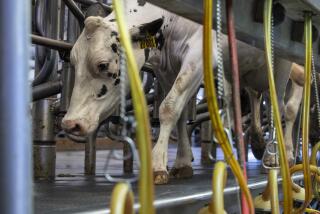Understanding an invasive bacterium
Are all E. coli strains capable of making us sick?
Only some, says microbiologist Alison O’Brien of the Uniformed Services University of the Health Sciences in Bethesda, Md. Many types of E. coli reside in animal guts, including ours. We coexist with our normal E. coli quite happily, although we may not be accustomed to strains living in people in other geographic locations. E. coli O157:H7 normally doesn’t inhabit human intestines, and humans aren’t adapted to deal with it.
Where did the strain O157:H7 come from?
It lives in the intestines and rectums of cattle, and some data suggest it might also reside in deer. Cow excrement is loaded with O157:H7 and can contaminate water supplies. Epidemiologists first isolated the strain in the mid-1970s. It became notorious after a food poisoning outbreak in the early 1980s, caused by tainted burgers at a fast food restaurant chain, and another similar outbreak in the 1990s.
Why is this strain so much more dangerous than the normal E. coli that live in our gut?
Instead of requiring millions of cells as do some pathogenic bacteria, E. coli O157:H7 can make people sick when they are exposed to only 10 to 50 cells.
The bacterium’s signature hazard is a toxic protein, called Shiga toxin, that is involved in the kidney failure affecting 6% to 15% of infected individuals. Luckily, the Shiga toxin genes can’t easily spread to the normal bacteria in people’s guts. They reside in a virus in the bacterium that doesn’t infect other bugs very well.
The strain also contains other genes that make it a pathogen, such as “adherence factors” that help the bacterium stick to human tissues and ones that direct the formation of other toxins. Researchers don’t yet know how important these toxins are.
How does E. coli O157:H7 wreak its havoc on the body?
Scientists aren’t clear on all the details. They do know that the bacterium settles into the colon and reproduces. Thanks to a protein called intimin and others produced by the pathogenicity island, it sticks well to the cells lining the intestines and invades the tissue, turning the gut leaky and causing diarrhea. The Shiga toxin, either directly or indirectly, damages kidney cells, possibly causing hemolytic uremic syndrome, which can lead to hospitalization and death. Some microbiologists think hemolytic uremic syndrome arises from damaged red blood cells and a failure of the blood to clot.
How do people get it?
Most cases come from eating contaminated food. The food could have been washed or processed with water tainted with cattle manure. Chlorinating the water in agricultural processing can help reduce the amount of bacteria. But it is hard to remove the bacteria in a home kitchen because the bacteria can form sticky biofilms that aren’t removed through washing.
Although this is rare, people can spread the bacteria by getting a bit of fecal matter on their hands and touching other people or preparing food for other people. It’s wise when preparing food to wash one’s hands often, especially around children.
What can I do to protect myself?
The best protection in the current outbreak has been to temporarily avoid raw spinach. In general: Cook ground meat thoroughly; keep raw meat separate from other foods; wash hands, counters and utensils with hot soapy water after they touch meat; drink pasteurized milk and juices.
More to Read
Sign up for Essential California
The most important California stories and recommendations in your inbox every morning.
You may occasionally receive promotional content from the Los Angeles Times.










